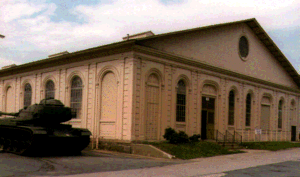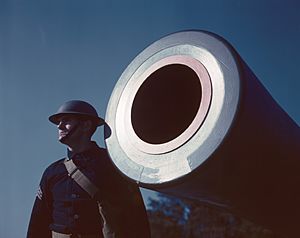Watervliet Arsenal facts for kids
|
Watervliet Arsenal
|
|

Historic Iron Building
|
|
| Location | Broadway Watervliet, New York |
|---|---|
| Area | 142 acres (57 ha) |
| NRHP reference No. | 66000503 |
Quick facts for kids Significant dates |
|
| Added to NRHP | November 13, 1966 |
| Designated NHL | November 13, 1966 |
The Watervliet Arsenal is a very important place for the United States Army. It's located in Watervliet, New York, right by the Hudson River. This arsenal is special because it's the oldest one in the U.S. that has been working non-stop! Today, it makes a lot of the big guns, like artillery and cannons, for the army. It also makes parts for mortars and tanks. Since 1966, it has been recognized as a National Historic Landmark, which means it's a really important historical site.
The arsenal started on July 14, 1813, to help during the War of 1812. It was officially named the Watervliet Arsenal in 1817. The arsenal covers 142 acres (about 57 football fields) of land. It is about 8 miles (13 km) north of Albany, New York. Its location next to the Hudson River is very useful. The site has factories, offices, and storage areas. It also has the Army's Benét Laboratories, where new products are developed and tested.
What Happens at Watervliet Arsenal?
The Watervliet Arsenal is a busy place. It has a historic building called the Iron Building. This building used to be home to the Watervliet Arsenal Museum. However, the museum closed in 2013.
The Arsenal also hosts offices for the United States Marine Corps. This is where people go to learn about joining the Marines. The main office for the United States Army Recruiting Battalion Albany also moved here in 2009.
How the Arsenal Began (1813–1823)
The arsenal was built near a village called Gibbonsville. This spot was chosen because it was perfect for transportation. It was on the Hudson River, not too far from Lake Champlain or New York City. It was also close to the Mohawk River, which led to Lake Ontario. During the early part of the War of 1812, these locations were important for defense.
The first goal of the arsenal was to make ammunition and small equipment. This included things like gun carriages, ropes, and tools for cannons. The Army bought 12 acres of land to start. Construction began in the summer of 1813. They built fourteen buildings, including gun houses, an arsenal, stables, and living quarters. The land cost $2,585.
Making Big Guns (1880s)
About 70 years after it opened, the Watervliet Arsenal became famous. In the late 1880s, it became the Army's first place to make large cannons. Before this, they made things like saddles and gun carriages.
Even today, parts of this history are still in use. For example, Building 110, known as "The Big Gun Shop," is still used for manufacturing. This shop once made huge 16-inch guns and other weapons. These weapons were used by the United States Army Coast Artillery Corps to protect the coast.


